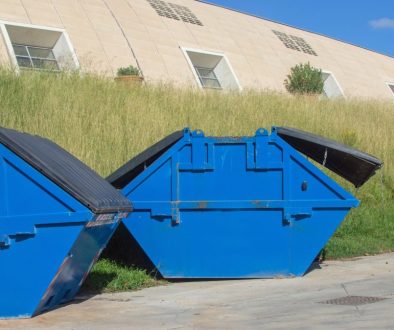Abandoned buildings and plots are common in many cities worldwide, including the UK. These structures and properties can present various problems that affect public safety, housing, and the environment. In this article, we will explore ten problems surrounding abandoned buildings and plots in detail, especially when there’s no skip hire around to get rid of rubbish:
1. Fire Hazards
Abandoned, unsecured areas can be particularly dangerous as they attract children who may start fires accidentally while playing. Additionally, arsonists may also target abandoned buildings and plots, increasing the risk of accidental fires. Combustible materials, such as old furniture, rubbish, and debris, can further exacerbate the spread of fires in these structures. The risks associated with abandoned buildings and many fire hazards highlight the need for regular maintenance, inspections, and secure fencing to prevent unauthorised entry.
2. Crime and Anti-Social Behaviour
Deserted buildings and plots can also be used to store stolen goods, making them a target for burglars. Illegal activities in abandoned buildings and plots can also attract violent crime, putting residents and nearby business owners at risk.
These structures can also become magnets for graffiti and vandalism, making the area look run-down and deterring potential residents and businesses. The presence of abandoned buildings and plots can be a significant challenge for local authorities and property owners, who must take measures to secure the properties and prevent them from becoming a hub for criminal activity and anti-social behaviour. This includes regular patrols, surveillance cameras, and secure fencing.
3. Property Values
Uninhabited structures also impact the quality of life for residents in the surrounding area. The presence of these structures can lead to increased noise pollution and a heightened risk of crime and anti-social behaviour. This can further deter potential residents and businesses from investing in the area.
Additionally, they can drain public resources, as local authorities may need to allocate funds to address the issues associated with these structures. The impact on property values can be significant, particularly in areas with desolate buildings. Local authorities and property owners must address these issues and prevent the proliferation of abandoned buildings and lots in their communities, such as by hiring a skip.
4. Squatters and Homelessness
These areas are often attractive to settlers and people experiencing homelessness, who may see them as temporary shelters. These individuals may break into the buildings to seek refuge, despite the risks associated with living in an abandoned property. Squatters and the homeless in the vicinity can lead to further problems with crime and anti-social behaviour, as these individuals may engage in illegal activities, such as drug use or theft.
The presence of settlers and people experiencing homelessness can also lead to a sense of unease and discomfort for nearby residents, who may feel unsafe in their neighbourhoods. Local authorities and property owners must prevent squatters and people without housing from accessing abandoned buildings and plots, whilst addressing the underlying issues leading to homelessness and social exclusion. This can include increased social services, affordable housing, and outreach programs.
5. Health Hazards
These places also risk public health by accumulating hazardous items like asbestos or lead paint. These materials can become a source of airborne particles that can be inhaled by nearby residents, resulting in respiratory problems and other health issues. The presence of hazardous materials can also make it difficult and expensive to clean up abandoned buildings and plots, further exacerbating the risks to public health.
Unoccupied buildings and plots can contribute to the spread of infectious diseases, such as tuberculosis, through the overcrowding and unsanitary conditions that can occur when squatters and people experiencing homelessness seek refuge in these properties. Local authorities and property owners must address these health hazards and prevent the proliferation of abandoned buildings and lots in their communities. This can include regular inspections, secure fencing, and the safe removal of hazardous materials.
6. Structural Deterioration
Abandoned buildings and plots can deteriorate over time due to lack of maintenance, environmental exposure, and vandalism. The structural integrity of these properties can be compromised, leading to collapses or other safety hazards. The risk of structural deterioration can increase if the property is left unsecured, allowing unauthorised individuals to enter and further damage the building.
7. Environmental Impact
Abandoned buildings and plots can have a significant environmental impact.These properties can become a dump for rubbish and hazardous waste, contaminating the soil and groundwater. These materials can also pose a health hazard to nearby residents and wildlife.
8. Urban Blight
Abandoned buildings and plots can contribute to urban blight. Urban blight refers to the decline of a neighbourhood or community due to neglect, disinvestment, and decay. The presence of abandoned buildings and plots can signal to potential residents and businesses that the area is in decline, further perpetuating the cycle of urban blight.
9. Legal Issues
Old, unused properties can present legal issues for owners and local authorities. Property owners may be responsible for maintaining abandoned buildings and plots, even if not occupying the property. If the property owner fails to manage the property, they may be subject to fines or legal action. Local authorities may also have the power to seize abandoned properties and sell them to recoup unpaid taxes or other debts.
10. Cost of Demolition and Clean-Up
Abandoned structures can be costly to demolish and clean up. These properties may contain hazardous materials, such as asbestos, which must be removed before demolition. The cost of demolition and clean-up can fall on the property owner or local authorities, depending on the circumstances.
Clean Up Your Community with a Skip
These areas present many problems that affect public safety, housing, and the environment. These structures can become fire hazards, breeding grounds for vermin, and havens for criminals and anti-social behaviour. The presence of abandoned buildings and plots can also lower property values, contribute to urban blight, and create legal issues for property owners and local authorities. Property owners and local authorities must address these problems and prevent the proliferation of abandoned buildings and plots in their communities.
Our company provides a ‘Wait and Load’ service, perfect for clients with restrictive areas, require quick waste disposal, or have been refused an on-road skip permit. With this service, we will wait a maximum of 20 minutes for you to load your skip, and then we will remove it immediately from the site. If you have any inquiries regarding this service, please do not hesitate to contact us at 01270-820-426 for more information on a Chester skip hire.




